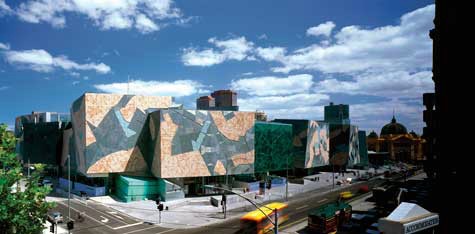
LAB's Donald Bates talks about the relationship between art and architecture, Federation Square and the public's responsibility to invest in design.
What is the relationship between art and architecture?
The difference is that architecture is unavoidable; it impacts upon people. You can choose to not look at a painting or go to a museum or gallery, but it’s pretty hard to close your eyes walking down the street. So architectural consequences are always ever present in that sense. The artworks that are included in the Draw the Line exhibition are reference points for us in terms of the development of both the design and idea behind the Federation Square project. But we look at artworks as architects not as artists, so certain ways of organizing space and ordering urban space interest us.
Should architecture have a cultural agenda?
No matter what you do it affects the environment and it affects people socially. When you take a project like Federation Square, which is set very much in the middle of the city and is really about the role of changing the way the city operates, you’re constantly engaged in dealing with the social, cultural and political consequences of an architectural project and a building.
Has Federation Square had an impact on the personality of Melbourne?
It works both ways; Federation Square itself helps to embody some of the things that already existed in the life and culture of Melbourne but at the same time it has made new possibilities emerge in the way people get together, socialise, express themselves, because it’s given that kind of backdrop for a whole range of possibilities that were hidden within the city prior to its existence. So it has become a centre point for a lot of the cultural and particularly multi-cultural activities. It’s also accentuated one of the great things about Melbourne: the close interaction between cultural, commercial and personal activities.
Has it made art more accessible?
The mid 20th century idea that art is a very special event that you get dressed up and go into is exemplified by the original national gallery, which looks like a bank building — totally closed on the outside, one entrance only — it feels as though you really shouldn’t be there unless know a lot about art.
By contrast, Federation Square is a much more open, almost democratic notion of the integration of art with daily life. It’s not something outside of daily life, it’s part of daily life.
How is the city’s architecture changing?
It’s evolving. Federation Square was one of many elements of a very important development of cultural infrastructure within the city, including the Melbourne Museum, the immigration museum and the whole range of cultural facilities that have been built over the past 10 to 15 years. Once those buildings exist they become a framework so that so many more things can happen. It allows for many more things to happen simultaneously.
What changes would invigorate the profession in Australia?
Err, work? Having work and opportunities would be big! We had a hard time doing Fed Sq because there was a lot of controversy about what it looked like, there’s a lot of controversy about the way it was designed and there’s a lot of controversy about the cost. The building was made to last 50 to 100 years and I think, in the contemporary condition where most buildings were seen as lasting 10 to 20 years maximum, the fact that the state government did eventually pay for a building of this quality and standard is an important thing. For architects, it’s not about the cost of the building it’s about the quality that’s achieved and it’s the long-term affects of quality versus cost.
The public has to be responsible because they are the most condemning if a building costs more. You have to see beyond the every day affect of how much things cost.
Draw the Line: the Architecture of LAB is exhibiting at the National Gallery of Victoria until 13 September 2009.
Along with conceptual drawings and studies, Draw the Line will also feature large architectural models of LAB’s subsequent projects (pictured below) formed in polystyrene and smaller balsa wood and cardboard models that reveal the overall creative breadth and innovative design of LAB architecture studio.


